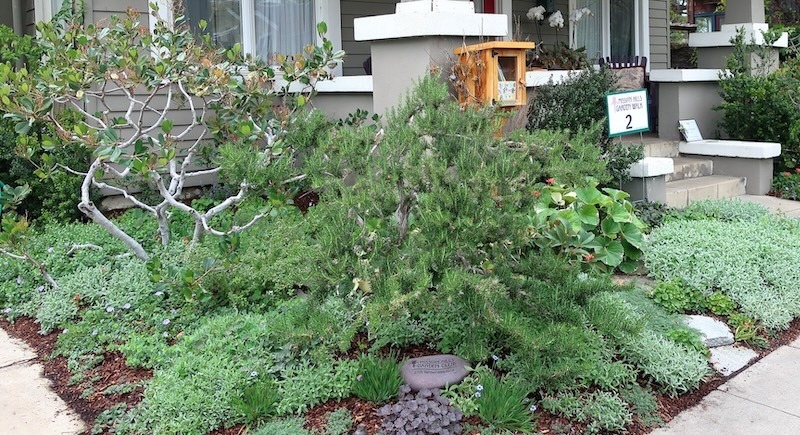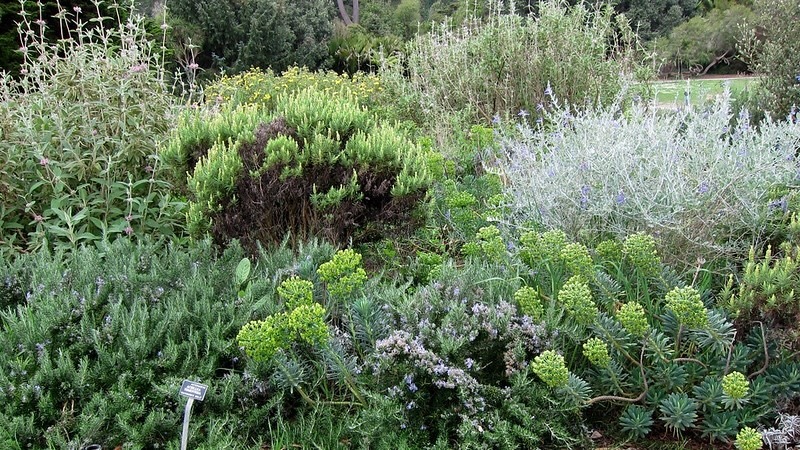Woody herbs like rosemary are perennials that perform many uses in the garden. The edible leaves and flowers of rosemary are culinary hallmarks of many recipes from the Mediterranean region. The deeply savory and floral flavor is enhanced with long roasting, stewing, or grilling. The fragrant woody stems and foliage also repel insects and other larger pests in the garden.
Rosemary performs as a shrub where it is fully winter hardy (generally USDA zones 7 and higher). Highly drought tolerant at maturity, it is an essential part of any waterwise or xeric garden plan. Grown as an annual or houseplant, rosemary looks great in decorative pots and makes a dramatic thriller element in a larger mixed-color design.

Photo by K M, cropped, Flickr, copyright CC BY 2.0 DEED
Rosemary requires well-draining soil that is not overly rich or heavy with clay. Mediterranean plants are accustomed to ample moisture during the cooler winter months, and dry, hot conditions during the summer. In a home garden, this translates to full sun exposure and sparse watering, even for container-grown plants. Rosemary thrives in poor soil and typically does not require fertilizing, even when grown as an annual.
Shrubs To Plant With Rosemary
Gardeners in USDA zones 7 and higher can plant upright rosemary varieties as part of a mixed shrub border or dedicated herb garden. Other woody herbs like lavender, thyme, and bay laurel thrive in the same growing conditions and attract beneficial insects when in bloom throughout the summer months.
Other shrubs used in xeric designs are also good companions for rosemary. Russian sage, sterile varieties of butterfly bush, juniper, and barberry all grow well in hot, dry conditions and have attractive foliage. Use varieties with contrasting shapes to create a low-maintenance garden bed with 12 months of interest.

Photo by K M, unmodified, Flickr, copyright CC BY 2.0 DEED
Perennials To Plant With Rosemary
The list of compatible perennials with rosemary is long, although any candidate must prefer drier soils with low nutrients. Some of the best perennial companions include yarrow, sage, euphorbia, most ornamental salvias, lemon balm, comfrey, alliums, rudbeckia, and black-eyed Susan.
You can also use taller rosemary types as an evergreen backdrop for pollinator or rock gardens. Rosemary’s height provides vertical contrast to lower-growing sedums, succulents, and ornamental grasses.
Annuals To Plant With Rosemary
The fragrant foliage of rosemary is good at repelling insect pests, and the flowers encourage beneficial insects such as bees. These two traits make rosemary an essential workhorse in kitchen gardens. The attraction of pollinators will benefit annual crops such as peppers, tomatoes, beans, and peas. Rosemary’s repellent properties will help keep the flies, root maggots, and fleas off root and cruciferous vegetables.
Rosemary’s upright or prostrate form can also complement ornamental annuals, such as zinnias, sweet alyssum, or morning glory. Some of these annuals can form a quick groundcover to suppress weeds during the growing season and add color to an edible garden or herb bed.
Best Companion Plants For Rosemary in Containers
One of the pleasures of growing rosemary near a patio or backdoor is the easy access to fresh clippings. Rosemary can be planted singly in a pot or used as a thriller in combination with colorful annuals and perennials. Choose annuals and perennials with shallow roots that won’t compete with the deeper-rooted rosemary.
Prostrate, or trailing, rosemary looks great in hanging baskets filled with other hot season bloomers such as euphorbia, calibrachoa, verbena, and lantana. The rosemary foliage contrasts nicely against finer-leaved annuals, plus you can snip the ends of the rosemary whenever needed in the kitchen.

Photo by K M, cropped, Flickr, copyright CC BY 2.0 DEED
Perennial rosemary could be used as a base for formal urns at an entryway or near an outdoor seating area. As the seasons change, you can add seasonal color plants like pansies, petunias, or zonal geraniums. Select dwarf varieties of rosemary that can live for many years in a container with other plants.
Containers for rosemary require excellent drainage every month of the year and may need to be moved to a sheltered position near a building or unheated greenhouse during periods of unusually cold weather. In colder areas, the containers can be moved indoors to ensure the plants overwinter successfully.
Plants Not To Grow With Rosemary
Garden plants that prefer very rich and moist soils are not appropriate to grow alongside rosemary. Basil, tomatoes, pumpkins, and other cucurbit vines are hungry plants that use much more nutrients than rosemary needs. Over-fertilization of woody herbs like rosemary will weaken the plant and reduce the fragrance and flavor of the foliage. Overwatering has the same effect on rosemary, and increases the risk of root rot.
Best Plants To Grow With Rosemary
Any plant that appreciates full sun and drier soils is a great choice to pair with rosemary. Use rosemary as a backdrop for brighter, long-blooming perennials in a cottage garden, or grow it with other Mediterranean herbs as part of a rock garden or xeric planting. In areas with cold winters, grow rosemary in a pot that can be placed outside during the summer and overwintered indoors for use in the kitchen.
 |
Author Robbin Small - Published 1-8-2024 |
